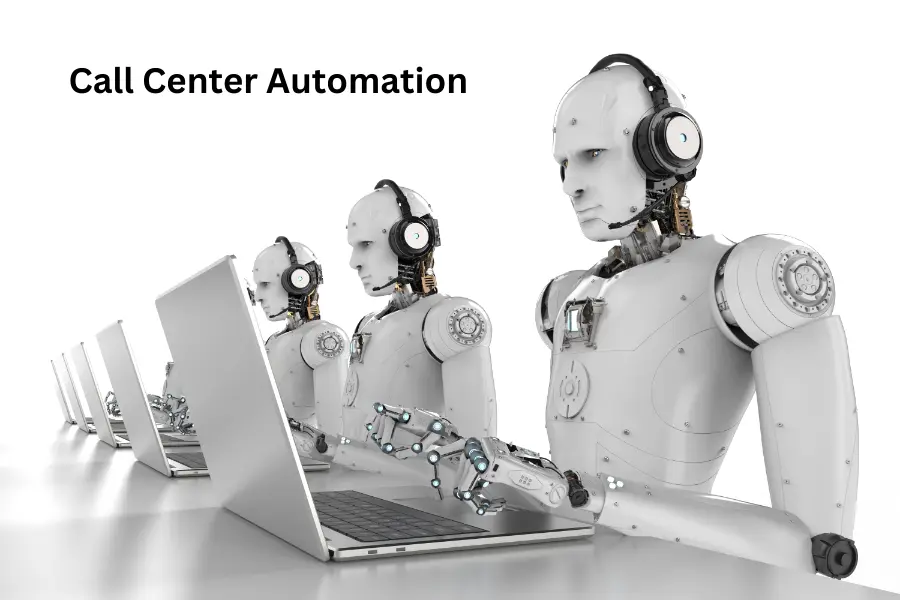What is Contact Center Automation?
In today’s fast-paced world, businesses need to keep up with the ever-growing demands of customers. It’s no secret that people expect quick and efficient service, and if you can’t meet those expectations, they’ll quickly look elsewhere. This is where contact center automation comes into play. By leveraging technology, automation allows businesses to handle routine customer interactions without the need for constant human intervention. The result? Operations become smoother, customers get faster responses, and everyone is happy.
Think about how many times you’ve waited on hold just to ask a simple question. With automated systems like IVR (Interactive Voice Response), chatbots, and virtual assistants, businesses can resolve common customer issues without needing a human agent. This makes the process faster and more efficient, so customers get quick answers, and businesses save valuable time and resources. Best of all, automation makes it easier for customers to reach out, any time of the day or night.
I’ve seen firsthand how powerful automation can be. Even with the most basic tools, businesses can drastically improve their service delivery. When it’s done right, the ability to offer fast, reliable responses—especially during peak times—is a total game-changer for both customers and businesses.
Why is Contact Center Automation Important?
So, why has contact center automation become such a vital part of business strategies today? For one, it allows companies to handle a higher volume of customer interactions without the need to constantly hire more agents. This is especially useful when demand peaks, like during holiday seasons or big sales events. Automation ensures customers aren’t left hanging in long queues—they get timely responses even when human agents are tied up.
What’s more, automation brings consistency and accuracy. When something is automated, there’s no room for error. For example, if a customer asks about their account balance, an automated system can fetch this data instantly from the database and provide an accurate response. This kind of reliability is often more dependable than relying solely on human agents. And, let’s face it, we’ve all been frustrated with long hold times and incorrect answers. Automation helps solve that problem.
The Role of Artificial Intelligence in Contact Center Automation
Let’s talk about Artificial Intelligence (AI)—it’s at the heart of many modern automation solutions. AI is changing the way businesses connect with customers. From AI-powered chatbots that provide 24/7 support to more advanced virtual assistants that understand and respond to natural language, AI is evolving rapidly. AI learns from past interactions, allowing it to offer personalized responses based on customer data.
What’s even more fascinating is AI’s ability to predict what customers need before they even ask. For example, if a customer often requests help with a specific service, the AI will recognize this pattern and offer proactive support, anticipating their next question or concern. Honestly, when I first saw AI’s potential in action, I was amazed. AI isn’t just about answering questions—it’s about predicting the next step, making the entire experience smoother for everyone.
However, it’s essential to remember that AI can never replace the empathy and human touch that agents provide, especially for complex or sensitive situations. While automation speeds up routine queries, the most meaningful customer relationships still depend on genuine human interaction.
Key Benefits of Contact Center Automation
There are some pretty compelling reasons to integrate automation into your contact center. Here are a few of the top benefits:
Efficiency Boost:
Automation handles repetitive tasks like answering frequently asked questions, giving human agents the freedom to tackle more complex problems.
Cost Savings:
By reducing the need for extra staff, businesses can cut operational costs while maintaining top-notch service.
Improved Customer Satisfaction:
When customers get faster, more accurate responses, their satisfaction levels go up, and with that comes loyalty.
24/7 Availability:
Automation tools like chatbots and IVRs are available at all hours, so customers can get help when they need it.
Scalability:
As your business grows, automation helps scale customer service operations without needing to hire tons of extra employees.
From my own experience, the true benefit of automation isn’t just about saving money—it’s about making operations smoother and more predictable. Businesses can rely on automation to keep things running efficiently, without having to worry about human error or inconsistency.
Challenges of Contact Center Automation
Of course, while automation has clear benefits, it’s not without its challenges. One concern many businesses face is the loss of human touch. Some customers still prefer talking to a real person, especially when dealing with complex or emotional issues. Automation is fantastic for handling routine tasks, but it’s important to know when to step in with a human agent for more personalized assistance.
Another obstacle is the initial investment. Automating your contact center requires an upfront commitment to technology, training, and integration. However, the long-term savings and efficiency gains usually outweigh these early costs.
Finally, data security must be top of mind. With automation systems handling sensitive customer information, businesses must ensure that their systems comply with data protection regulations and are secure. Investing in secure platforms and following best practices for data encryption is a must.
Types of Contact Center Automation Technologies
There are several automation technologies that businesses can adopt, depending on their needs. Some of the most common ones include:
Interactive Voice Response (IVR):
IVR systems let customers interact with a phone system to either route them to the correct department or answer simple questions.
Chatbots:
AI-powered chatbots are used to handle customer queries on websites and messaging platforms, helping with everything from simple answers to product recommendations.
Robotic Process Automation (RPA):
RPA automates repetitive back-office tasks like data entry or order processing, allowing human agents to focus on more complex issues.
Virtual Assistants:
These AI-powered assistants provide personalized support for more complicated queries, taking customer data into account to deliver tailored solutions.
In my experience, businesses often see the best results when they combine multiple automation tools—IVR for routine calls, chatbots for quick inquiries, and RPA for backend tasks. When used together, these systems provide comprehensive support for both customers and agents.
How Contact Center Automation Improves Customer Experience
The ultimate goal of contact center automation is to improve the customer experience. When done right, it speeds up responses, increases efficiency, and provides more personalized service.
Imagine calling a company for support. Instead of waiting forever on hold, an automated system quickly evaluates your issue and sends you directly to the right solution. This saves time and ensures that your problem is addressed immediately.
Automation tools like chatbots also help by offering immediate responses, letting customers resolve issues at any time of day. Whether it’s placing an order, checking an account balance, or sorting out a billing problem, automation ensures customers get fast service.
I can’t recall the last time I had to wait on hold with a company that uses chatbots. That instant satisfaction is something we all appreciate, and I think we’re all starting to prefer this smooth, immediate service. However, there are still moments where human interaction is needed, especially for more complicated or sensitive issues.
Contact Center Automation and Its Impact on Workforce Management
Automation isn’t just about improving customer interactions; it also plays a huge role in workforce management. By handling repetitive tasks, automation allows human agents to focus on more complex and rewarding work. This shift not only makes their work more engaging but can also lead to higher job satisfaction and lower turnover.
Moreover, automation provides valuable real-time analytics, giving managers insights into performance, staffing, training, and workload distribution. This data helps businesses run more efficiently by identifying areas where agents may need additional support.
From my own observations, agents are much more engaged when they’re not bogged down by repetitive tasks. Automation gives them the freedom to focus on problem-solving and customer relationships, which leads to a more rewarding work environment.
Steps to Implement Contact Center Automation
If you’re considering automation for your contact center, here’s how to get started:
Evaluate Needs and Goals:
Identify the repetitive tasks and set clear objectives (e.g., reduce wait times, improve accuracy).
Choose the Right Tools:
Based on your goals, select tools like IVR, chatbots, or virtual assistants.
Integrate with Existing Systems:
Ensure your automation tools seamlessly integrate with your CRM and other systems.
Train Staff:
Equip your agents with the skills they need to work alongside automation tools effectively.
Monitor and Optimize:
Regularly assess performance, collect customer feedback, and make necessary improvements.
I’ve helped clients implement automation tools, and it’s crucial to spend time ensuring proper integration. Doing so ensures everything works smoothly right from day one.
Future Trends in Contact Center Automation
The future of contact center automation looks promising. Here are some trends to watch:
Advanced AI Integration:
AI will evolve to handle not just basic tasks but also predictive analytics and proactive support.
Omni-channel Automation: A seamless experience across all touchpoints—phone, email, live chat, and social media—will be essential.
Natural Language Processing (NLP):
NLP will help chatbots understand and respond to more complex customer queries.
AI-Powered Workforce Management:
AI will optimize agent scheduling and workload balancing, helping businesses handle high volumes of customer interactions more efficiently.
Voice Recognition and Biometrics:
Voice recognition will be key to automating customer verification and improving service.
The Importance of Personalization in Automation
While automation continues to grow, personalization remains crucial. AI must go beyond answering questions to providing responses tailored to each customer’s history, preferences, and behavior. This kind of personalized interaction helps businesses build stronger customer relationships, even when the interaction is automated.
I’ve witnessed firsthand how customers appreciate businesses that take their unique needs into account. Personalization helps maintain the human touch, even when interacting with automated systems.
How Automation Enhances Customer Loyalty
In the end, automation’s main goal is to improve the customer experience, which drives customer loyalty. By providing faster responses, personalized service, and 24/7 support, automation helps businesses build lasting customer relationships. When customers have positive experiences, they’re more likely to stay loyal and recommend the business to others.
In my view, customer loyalty comes down to convenience and satisfaction. When customers know they can rely on a business to solve their problems quickly, they’re more likely to return.
Conclusion
In conclusion, contact center automation is changing the way businesses interact with customers. By leveraging tools like AI, chatbots, and other automation solutions, businesses can boost customer satisfaction, improve efficiency, and lower costs. As these solutions continue to evolve, businesses will not only meet but exceed customer expectations, paving the way for long-term success and customer loyalty.

